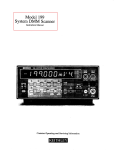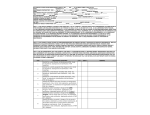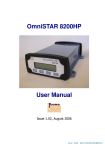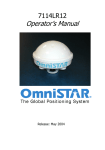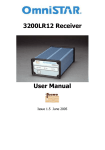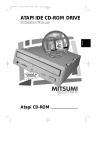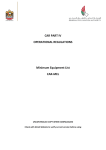Download OmniSTAR 5220HP User Manual
Transcript
OmniSTAR 5220HP User Manual Issue 1.32 Dec. 2010 OmniSTAR 5220HP User Manual Notice to Customers This manual has been produced to ensure the very best performance of your OmniSTAR receiver, as well as to ensure its trouble free usage. This publication could contain technical inaccuracies or typographical errors. Changes are periodically made to the information herein; these changes will be incorporated in new editions of the manual. Should you require further assistance please contact your local dealer or the OmniSTAR office. OmniSTAR Customer Support and 24-Hour Help Line The Netherlands: OmniSTAR B.V. Dillenburgsingel 69 2263 HW Leidschendam The Netherlands Tel: +31 70 317 09 00 Fax: +31 70 317 0919 Web : www.omnistar.nl E-Mail: [email protected] Australia: OmniSTAR Pty Ltd Tel: +61 8 9322 5295 Fax: +61 8 9322 4164 Web : www.omnistar.com.au E-Mail: [email protected] South Africa: OmniSTAR Pty Ltd Tel: +27 11 315 0420 Fax: + 27 11 312 1774 Web : www.omnistar.co.za E-Mail: [email protected] Singapore: Fugro OmniSTAR Pte Ltd Tel: +65 6542 5001 Fax: +65 6542 2208 E-Mail: [email protected] USA: OmniSTAR Inc. Tel: +1 713 785 5850 Fax: +1 713 785 5164 Web: www.omnistar.com E-Mail: [email protected] Issue 1.32 12/2010 ii OmniSTAR 5220HP User Manual One-Year Limited Hardware Warranty OmniSTAR B.V and its operating companies world-wide (OmniSTAR), warrants this product to be free from defects in workmanship and material for a period of one year from the date of original sale by OmniSTAR or its authorised dealers, to the original purchaser or end user. OmniSTAR reserves the right to repair and/or replace, at its option, any part or parts found to be defective, provided such defects, in their opinion, are due to faulty material or workmanship and are not caused by unauthorised or improper repair or abuse, or normal wear. Purchaser shall be responsible for shipping and insurance of the returned product for repair under this warranty. OmniSTAR will pay shipping and insurance for the product's return to purchaser provided that the product returned proves to be defective under this limited warranty. This warranty applies only to normal usage of the product. It does not apply to units or electronic circuit boards defective due to improper installation or handling. Physical damage due to lightning or other electrical discharge and units subjected to fresh or salt-water contamination are not covered. OmniSTAR reserves the right not to warrant the product if, upon request, sufficient proof of recommended installation compliance as laid out in this manual is not provided. No other warranties are expressed or implied. No other warranties exist. OmniSTAR assumes no responsibility for any consequential or incidental losses or damages of any nature with respect to the use of this product. Issue Issue 0.1 Issue 1.0 Issue 1.1 Issue 1.2 Issue 1.31 Date January 2009 January 2009 01 April 2009 19 June 2009 08 Sep 2009 Issue 1.32 24 Dec 2010 REVISION HISTORY Description Initial draft derived from 5120VBS Changes made by RH Added Firmware upload. Nmea selection Added Seeding Modified AFSAT to EUSAT replaced surveyplanner for skyfix WEEE Waste Electrical & Electronic Equipment Directive Check HV HV HV HV HV HV Manual Reference: OmniSTAR 5220HP User Manual Copyright OmniSTAR B.V. 2010. No part of this manual can be reproduced without the express permission of OmniSTAR B.V. Issue 1.32 12/2010 iii OmniSTAR 5220HP User Manual TABLE OF CONTENTS INTRODUCTION .................................................................................................. 8 ABOUT THIS MANUAL .......................................................................................... 8 SYSTEM FEATURES ............................................................................................. 8 RECEIVER FEATURES .......................................................................................... 9 HOUSING ............................................................................................................ 9 Accessories............................................................................................ 10 RF Input ................................................................................................. 11 INSTALLATION AND SET UP ........................................................................... 13 INSTALLATION CONSIDERATIONS ........................................................................ 13 COUNTER ELECTROMAGNETIC FORCE (CEMF) ................................................... 14 CABLE INSTALLATION ........................................................................................ 14 FEATURES AND INFORMATION ............................................................................ 15 One Pulse Per Second ........................................................................... 15 Event marker .......................................................................................... 15 Receiver status....................................................................................... 15 MOUNTING THE RECEIVER.................................................................................. 16 POWER SUPPLY REQUIREMENTS ....................................................................... 17 OPERATING CONSIDERATIONS...................................................................... 18 NUMBER OF VISIBLE SATELLITES ......................................................................... 18 MULTIPATH ....................................................................................................... 18 POSITION DILUTION OF PRECISION (PDOP) ........................................................ 19 SATELLITE ELEVATIONS ..................................................................................... 19 OMNISTAR CORRECTIONS ................................................................................ 19 INTERFERENCE ................................................................................................. 19 GETTING STARTED .......................................................................................... 20 CONFIGURATION ............................................................................................... 20 INSTALLATION ................................................................................................... 20 STARTING UP THE RECEIVER .............................................................................. 21 COMMUNICATION WITH THE RECEIVER ................................................................ 22 Serial ports ............................................................................................. 22 USB Ports .............................................................................................. 22 USB Logging .......................................................................................... 23 THE MENU SYSTEM ......................................................................................... 24 TOP MENUI .................................................................................................... 27 GPSI .................................................................................................... 27 L-BandI ................................................................................................ 27 Config WizardI ..................................................................................... 27 System SetupI ..................................................................................... 27 GPSI ............................................................................................................ 28 Position statusI .................................................................................... 28 SatellitesI ............................................................................................. 29 Issue 1.32 12/2010 iv OmniSTAR 5220HP User Manual ConfigureI ............................................................................................ 29 L-BANDI ........................................................................................................ 30 Signal StatusI....................................................................................... 30 ConfigureI ............................................................................................ 30 SubscriptionI ........................................................................................ 30 Diff IL-Band.......................................................................................... 30 CONFIG W IZARDI............................................................................................ 31 Proceed WizardI .................................................................................. 31 Save CurrentI....................................................................................... 31 Delete SavedI ...................................................................................... 31 Use Previous .......................................................................................... 32 CancelI................................................................................................. 32 SYSTEM SETUPI ............................................................................................. 33 Display AppsI....................................................................................... 33 Display FormatI.................................................................................... 33 Baud RatesI ......................................................................................... 33 Display LogsI ....................................................................................... 33 Software DispI...................................................................................... 34 ContrastI .............................................................................................. 34 AnimationIOff ....................................................................................... 34 SubscriptionI ........................................................................................ 34 Flip DisplayINO .................................................................................... 34 LCD OffInever ...................................................................................... 34 LanguageI............................................................................................ 34 DATA LOGGINGI ............................................................................................. 35 ConfigI ................................................................................................. 35 Start RecordingI ................................................................................... 35 TERMINAL COMMANDS................................................................................... 36 BASIC COMMANDS ............................................................................................. 37 $JI .......................................................................................................... 38 $JSHOW ................................................................................................ 39 $JT ......................................................................................................... 41 $JAGE.................................................................................................... 41 $JMASK ................................................................................................. 42 $JNP ...................................................................................................... 42 $JASC .................................................................................................... 43 $JOFF .................................................................................................... 44 $JAPP .................................................................................................... 44 $JBAUD ................................................................................................. 45 $JRESET ............................................................................................... 45 $JSAVE.................................................................................................. 46 OMNISTAR COMMANDS .................................................................................... 47 $JFREQ ................................................................................................. 48 $JLBEAM ............................................................................................... 49 $JLBEAMEX........................................................................................... 50 $JGEO ................................................................................................... 51 $JOMS ................................................................................................... 52 $JLIMIT .................................................................................................. 52 Issue 1.32 12/2010 v OmniSTAR 5220HP User Manual $JASC,D1 .............................................................................................. 53 $JOMD ................................................................................................... 54 SEEDING........................................................................................................ 55 $JHP,POS,PRESENT ( or $JHP,POS,P ) ............................................ 55 $JHP,POS.............................................................................................. 55 $JHP,SEED, lat,lon,hgt .......................................................................... 56 NMEA MESSAGES ............................................................................................ 57 APPENDIX A...................................................................................................... 58 TECHNICAL SPECIFICATIONS .............................................................................. 58 Signals ................................................................................................... 58 Environmental ........................................................................................ 58 Data inputs & outputs ............................................................................. 58 Connectors ............................................................................................. 58 Power ..................................................................................................... 59 Physical Characteristics ......................................................................... 59 Position Accuracy................................................................................... 59 Initialisation times: .................................................................................. 59 Signal Reacquisition ............................................................................... 59 Dynamics ............................................................................................... 59 Data Pin-out ........................................................................................... 60 Standard Accessories............................................................................. 60 APPENDIX B...................................................................................................... 61 NMEA 0183 MESSAGE OPTIONS ........................................................................ 61 NMEA 0183 MESSAGE FORMATS ...................................................................... 61 GGA – GPS Fix Data ........................................................................ 62 GLL – Geographic Position - Latitude/Longitude .............................. 63 RRE – GPS Range Residual Error.................................................... 63 GSA – GPS DOP and Active Satellites ............................................. 64 GST – GPS Pseudorange Noise Statistics ....................................... 65 GSV – GPS Satellites in View........................................................... 66 RMC – Recommended Minimum Specific GPS Data ........................ 67 VTG – Course Over Ground and Ground Speed............................... 68 ZDA – Time and Date....................................................................... 69 APPENDIX C...................................................................................................... 70 ACRONYMS USED IN THIS MANUAL ...................................................................... 70 APPENDIX D...................................................................................................... 72 USB DRIVER FOR 5220HP ................................................................................ 72 APPENDIX E...................................................................................................... 74 UPDATING THE 5220HP FIRMWARE .................................................................... 74 INSTRUCTIONS FOR LOADING THE FIRMWARE FOR THE 5220HP : .......................... 74 APPENDIX F ...................................................................................................... 75 OMNISTAR REFERENCE STATIONS ..................................................................... 75 Issue 1.32 12/2010 vi OmniSTAR 5220HP User Manual APPENDIX G ..................................................................................................... 76 TEST RESULTS .................................................................................................. 76 APPENDIX H...................................................................................................... 78 RECEIVER SERVICE PROCEDURE ....................................................................... 78 APPENDIX I ....................................................................................................... 79 OMNISTAR RECEIVER PROBLEM REPORT FORM ................................................ 79 APPENDIX J ...................................................................................................... 80 MECHANICAL DRAWING FOR MOUNTING............................................................... 80 APPENDIX K...................................................................................................... 82 WEEE: W ASTE ELECTRICAL & ELECTRONIC EQUIPMENT DIRECTIVE ................... 82 W ASTE TREATMENT ON YOUR OWN RESPONSIBILITY ............................................ 82 ECOLOGICAL BACKGROUND ............................................................................... 82 LIST OF FIGURES Figure 1: 5220HP Back Panel ............................................................................ 10 Figure 2: Ant-Aero-06 antenna ........................................................................... 11 Figure 3: Drawing Ant-Aero-06 antenna.............................................................. 12 Figure 4: Multipath.............................................................................................. 18 Figure 5: the receiver home screen .................................................................... 26 Figure 6: Example of an Easylog window ........................................................... 36 Figure 7: DB9 pin layout on receiver (female connector) .................................... 60 Figure 8: screen view of PORTS in device manager........................................... 73 LIST OF TABLES Table 1: 5220HP Interfaces ................................................................................ 10 Table 2: Basic commands .................................................................................. 37 Table 3: OmniSTAR commands ......................................................................... 47 Table 4: OmniSTAR beams worldwide ............................................................... 48 Issue 1.32 12/2010 vii OmniSTAR 5220HP User Manual Introduction About This Manual This manual has been produced to assist the typical user with the installation and operation of the OmniSTAR 5220HP DGPS Receiver. System Features The OmniSTAR 5220HP DGPS Receiver is part of the OmniSTAR worldwide DGPS Service. The OmniSTAR service is a full-time differential GPS (DGPS) broadcast system delivering corrections from an array of GPS reference stations located around the globe. Reference stations provide industry standard formatted corrections to Network Control Centres (NCC’s) at strategic geographic locations, where the corrections are decoded, checked, and repackaged in a highly efficient format for broadcast. The data is modulated onto an RF carrier that is then up-converted for transmission to an L-band communications satellite. The signals are received at the user's location by an antenna, demodulated by a receiver, and are made available, after selection of the desired individual reference site's data set, as corrections for use in a GPS, differential-capable, receiver. The OmniSTAR 5220HP receivers support the following OmniSTAR® service: VBS, this is the Virtual Base Station service where single frequency GPS code and phase measurements are used to create RTCM corrections data optimised for the users current position. HP, this is the OmniSTAR High Performance solution using ground reference stations giving decimetre level accuracy using dual GPS frequency code and phase measurements XP, this is the OmniSTAR eXtended Performance solution using precise satellite orbit and clock corrections giving decimetre level accuracy worldwide using dual GPS frequency code and phase measurements HP+, this is the combined mode in which corrections from HP and XP are merged to give one seamless worldwide decimeter level solution. Issue 1.32 12/2010 8 OmniSTAR 5220HP User Manual Receiver Features The OmniSTAR 5220HP receiver has the following features: • • • • • • • • • • • • 12 parallel GPS code/carrier tracking channels (L1/L2 code and carrier) and 3 additional L1 channels. LCD top panel display Receiver configuration using the front panel 5 cm accuracy (RMS), assuming at least five satellites and a PDOP (Position Dilution of Precision) Input Voltage 8 to 36 VDC Low power consumption (typically < 5.8 Watt at 12 VDC) 1, 5, 10 Hz position output data user selectable, (20 Hz optional) A rugged, environmentally-sealed enclosure Two RS232 data ports with DB9 connectors, supporting the following protocols: RS-232: NMEA-0183 output, RTCM SC-104 input and output, ASCII input, proprietary binary input (if enabled) 1PPS (1 Pulse per second) strobe signal to enable an external instrument to synchronize its internal time with a time derived from the very accurate GPS system time. Event marker GPS antenna connector 1 USB 2.0 type B connector to connect a computer 1 USB type A connector to connect a USB 2.0 Memory Stick Housing The 5220HP is housed in an enclosure to provide a complete receiver solution. When connected to an antenna and a power source, the 5220HP is a fully functioning GPS receiver. The enclosure offers protection against environmental conditions and RF interference. In addition, it provides an easy-to-use interface to the data, power and status signals of the GPS card and a rugged, water, shock and vibration resistant housing for outdoor applications. Issue 1.32 12/2010 9 OmniSTAR 5220HP User Manual Accessories The following accessories are included with the 5220HP: • • • • • • 1 power cable 1 RS232 data cable 1 USB cable (to connect a computer) 1 antenna cable (5 meters) A CD containing PC utilities and product documentation Figure 1: 5220HP Back Panel Name Description ON/OFF On/off power switch POWER 8 - 36 V DC power input Antenna Antenna connection 50 ohm DATA COM USB type B wired connector MEM Stick USB type A port for USB Memory stick PORT A RS-232 signals, PORT B RS-232 signals, 1PPS and auxiliary strobe signal GROUND An extra ground terminal for grounding your receiver Table 1: 5220HP Interfaces Issue 1.32 12/2010 10 OmniSTAR 5220HP User Manual RF Input The 5220HP is designed to work with active GPS antennas with a LNA gain of 10 to 40 dB. The purpose of this LNA gain above the minimum requirement of 10 dB is to accommodate for losses in the cable system. Essentially, there is a maximum cable loss budget of 30 dB for a 40 dB gain antenna. Depending on the chosen antenna, the loss budget will likely be lower (a 24 dB gain antenna would have a 14 dB loss budget). When using an antenna and antenna cable please make sure not to exceed the loss budget. Otherwise, the tracking performance of the 5220HP will be compromised. The standard antenna for the 5220HP receiver is the Ant-Aero-06 antenna. Figure 2: Ant-Aero-06 antenna Issue 1.32 12/2010 11 OmniSTAR 5220HP User Manual Figure 3: Drawing Ant-Aero-06 antenna Issue 1.32 12/2010 12 OmniSTAR 5220HP User Manual Installation and Set Up Installation Considerations Before commencing installation of the OmniSTAR 5220HP in a vehicle or aircraft, the following should be considered: • Determine the preferred location for each unit. Consider cable length, connector attachment space (cable bend radius), stowing excess cable, moisture, chemical corrosion, vibration and heat exposure. • Before drilling holes, consider using existing hardware and locations where equipment was previously installed. Avoid drilling holes that may damage other equipment (e.g. structural frame members, electrical cables or fluid lines). • High vibration and high temperature locations should be avoided whenever possible. • In application where vibration exceeds 5Gs acceleration, shock mounts are required. (Refer to Customer support for mounting recommendations). • Vehicle primary power has voltages that may be harmful to personnel and equipment. Disconnect the battery cable from the battery (negative) terminal before making connection to any power terminal within the vehicle. Issue 1.32 12/2010 13 OmniSTAR 5220HP User Manual Counter Electromagnetic Force (CEMF) A potential problem inherent in any installation of electronic systems within a vehicle is Counter Electro-Magnetic Force (CEMF). CEMF is caused when relays or solenoids, connected to the vehicle DC power distribution, are de-energised. The voltage produced may exceed 400 volts. CEMF is produced by equipment such as the following: • Electric fan brakes • Air conditioners • Starter relays • Electric pump relays CEMF is more than sufficient to damage or cause erratic operation of any electronic system that is also connected to the same vehicle DC power supply. CEMF can be eliminated by installing diodes at the relays and solenoids that cause the problem, and more importantly at the power supply cable connections on the receiver. Cable Installation Cables must be correctly installed for optimum system operation. Therefore, the following should be noted: • Do not route an L-Band receiver remote antenna cable with the cabling of any other radio system. This may cause interference between both systems. • If at all possible, do not run L-Band receiver antenna cables parallel to other radio system cabling closer than 30 centimetres. • If cables must cross, ensure that they cross at an angle of 90°. This minimises the possibility of interference. • As far as is practicable, ensure that cables and I/O connectors are unique and fit only in their allocated location. • Avoid routing cables along-side power generator cabling and other high electrical noise sources. This can cause interference. Issue 1.32 12/2010 14 OmniSTAR 5220HP User Manual • Do not kink cables or force cables into sharp bends that may damage the cables and cause system failure. • After installation, ensure that excess cable is looped and clamped or tied safely away from any control cables, fuel lines, hydraulic lines or moving parts. • When stowing over length cabling, form loops not less than 150 mm minimum cable bend radius. • Cable routing must avoid high temperature exposure (e.g. exhaust manifold). Features and Information This section contains information on the features of the 5220HP receiver. One Pulse Per Second The strobe available on the 5220HP is the One Pulse Per Second (1 PPS) signal. The output is 3.3 Volts and duration is 1 microsecond. ( Port B, pin 9 ) The rising edge of this signal is synchronised with GPS time. Event marker Event marker input creates the possibility to generate a marker with for instance a camera that shows up in the data stream. The marker is active low, falling edge sync, 10 k-ohm, 10 pF load. ( Port B, pin 6 ) Receiver status The 5220HP is equipped with an LCD display showing the status of the receiver. Using the display and the buttons around the display, the receiver can be configured without the need to connect a computer. The functions of the LCD display and the configuration menus are described further on in this manual. Issue 1.32 12/2010 15 OmniSTAR 5220HP User Manual Mounting the receiver The 5220HP casing is equipped with two mounting brackets to facilitate mounting the receiver to a surface. This section provides information on how to mount the receiver. Note: The receiver casing was not designed for mounting in high-dynamics or high-vibration environments. To mount the 5220HP receiver: 1. Use the slots on the side of the receiver to place the mounting brackets. 2. Mark where the holes need to be and then drill holes in the mounting surface. 3. Use screws to secure the casing to the mounting surface. When using machine screws, tap the mounting holes to fasten the receiver to the mounting surface. Alternatively, self-tapping screws can be used. 4. Make sure not to mount the receiver in a location where it can easily be damaged during normal operation. Try to protect the receiver against harsh environmental conditions. When choosing a mounting location, please ensure the menu screen, LEDs and buttons are visible and accessible. Also make sure it is possible to access the back panel, in order to switch cables or operate the power button. There is an option within the menu system to switch the direction of the display, so if it is easier for you to mount the unit upside down, you may do so and still operate the display easily. Issue 1.32 12/2010 16 OmniSTAR 5220HP User Manual Antenna Location Antenna positioning is critical to system performance. The following conditions must be met for optimum system performance: 1. Antenna must be mounted at least 1.5 metres away from transmitting antennas of any frequency. Closer positioning may cause overloading of receiver RF circuits. 2. The antenna should be mounted at the highest practical point that will give a good view of the horizon and be as near level as possible. 3. The antenna must be located along the vehicle centre-line, or at a relevant reference point on the vehicle. 4. The antenna should not be mounted in a location where it can easily be damaged during normal operation. Power Supply Requirements The 5220HP can be powered by a vehicle or by a customer-supplied power source of 8-36 VDC, capable of delivering at least 6W continuous output power. For continued protection against the risk of fire, the power lead to the 5220HP receiver should be provided with a 10 Ampere (maximum) fuse. Warning: Before powering the receiver, make sure the antenna cable and antenna are connected and the power and data cable is connected and secured. Connecting or disconnecting an antenna or antenna cable when the receiver is already powered may permanently damage the receiver’s antenna port or the antenna itself, voiding your warranty. Connecting or disconnecting the power/data cable to/from the receiver when the cable is already powered may result in increased wear or an early failure of the power/data connector. Warning: If the voltage supplied is below the minimum specification, the receiver will suspend operation. If the voltage supplied is above the maximum specification, the receiver may be permanently damaged, voiding your warranty. Issue 1.32 12/2010 17 OmniSTAR 5220HP User Manual Operating considerations The 5220HP has proven to be a high-quality positioning device. The accuracy that the user can obtain depends on several factors, including: • • • • • Number of visible satellites Multipath Dilution of Precision (DOP) Satellite elevations OmniSTAR corrections Number of visible satellites A minimum of four satellites is required to calculate a 3-dimensional position. In general it can be said that every increase in the number of visible satellites will result in an increase in the systems’ accuracy. As the GPS satellites orbit the earth the number of visible satellites will change in time. The GPS constellation has been designed to provide a minimum of 4 visible satellites at any location at all times. The number of visible satellites can decrease due to blockage by objects such as trees and buildings. Multipath It is possible for satellite signals to reflect off large nearby objects such as buildings, cars or even the ground, thereby resulting in an erroneous distance measurement. This phenomenon is known as multipath. Multipath can cause significant errors in the position determination and it is therefore important to place the receiver in an environment, which is free of large reflective surfaces. It is also recommended to mount the receiver directly onto a surface, while maintaining a clear view of the sky in all directions. Figure 4: Multipath Issue 1.32 12/2010 18 OmniSTAR 5220HP User Manual Position Dilution of Precision (PDOP) The Position Dilution of Precision (PDOP) is a measure of the satellite geometry. The closer to 1 the PDOP value, the more accurate the GPS position will be. Satellite elevations The signal from a satellite that is low on the horizon will travel a greater distance through the atmosphere. This results in lower signal strength and a delayed reception, thereby causing erroneous and noisy data. By default the 5220HP is configured to ignore any GPS satellites that have an elevation angle lower than 8°. OmniSTAR corrections For accurate positioning it is essential that the differential corrections are received. In order to ensure reception of the OmniSTAR satellite signal the line of sight towards the satellite must not be blocked by objects such as trees and buildings. To find out which OmniSTAR satellite(s) can be received at your geographic position, please visit the survey planner website (http://www.surveyplanner.com). Interference Although the 5220HP has been designed to provide optimal system performance under most circumstances, due to the nature of radio communications it is possible, that the system performance degrades as a result of local interference sources. When interference levels are too high, the 5220HP may even lose lock to either the OmniSTAR satellite or the GPS satellites. Interference sources include radio and television transmitters, radars, microwave ovens, poorly shielded spark plugs and aeronautical radio navigation systems, in short: any device producing electromagnetic energy (directly or through harmonic frequencies) in the 1525 - 1580 MHz band. Issue 1.32 12/2010 19 OmniSTAR 5220HP User Manual Getting started The purpose of this section is to get you started with the 5220HP as quickly as possible. Configuration Generally, when the receiver is supplied, it will be configured for the mode and data link(s) you have subscribed to. In most cases getting up and running will be a easy as connecting the appropriate cables and applying power to the system. Configuring the receiver via direct commands will be treated later in the section “Communication with the Receiver” If at any time you need to return the menu system to the factory default configuration, simply hold down the “enter” key on power-on until the splash screen disappears. Installation Before operating the receiver for the first time, ensure that the installation instructions (below) have been followed correctly. 1. Mount the 5220HP receiver in a suitable place (see page 16). 2. Mount the OmniSTAR Aero-06 antenna in a suitable place (see page 17). 3. Connect the antenna to the receiver using an antenna cable, making sure that both connectors are secured well. Secure the antenna cable using tie wraps. 4. Connect the data cable to port A of the 5220HP receiver. 5. Connect the receiver to a suitable (8-36 V DC) power supply using the powercable. Issue 1.32 12/2010 20 OmniSTAR 5220HP User Manual Starting up the receiver Power up the receiver by pushing the power button at the back of the receiver once. The 5220HP uses three LEDs. The LED functions are defined as: Power Indicator LED: red. This LED will illuminate when the 5220HP is powered. GPS Lock Indicator LED: yellow. This LED will remain illuminated once the receiver has solid GPS lock. HP Position Indicator LED: solid green or blinking. This LED will illuminate solid green when the receiver has achieved a differential position and a pseudo range residual of better than 10.0 meters (default value, can be changed). If the residual value is worse than the current threshold, the green LED will blink indicating that differential mode has been attained, but that the residual has not met the threshold. Note: The first start-up can take from 10 to 20 minutes depending on your location. Subsequent start-ups will output a valid position within 1-2 minute depending on your location and time since the last start-up. Note: The receiver can take up to 60 minutes for a full network map to be received from OmniSTAR satellites. Optimum accuracy will be obtained once the unit is processing corrected positions using complete network information. Issue 1.32 12/2010 21 OmniSTAR 5220HP User Manual Communication with the Receiver There are three different options to communicate with the receiver: - using the receiver’s menu system which is accessable through its front panel and LCD screen. - using a terminal program on a Microsoft Windows-based computer - using Viewall on a PDA. Serial ports The 5220HP features two serial ports. The ports handle communication to and from the GPS Receiver. The ports may be configured for a mixture of NMEA 0183, binary data and RTCM SC-104 data. USB Ports The USB configuration of the 5220HP receiver comprises two USB-A male connectors. Each port has its function marked on the end plate of the receiver. The port marked “Data Com” is wired as USB-B port for data communication with the receiver. There is a USB-A to USB-A cable included with your receiver to use with this port. Connect one end of the supplied cable to the receiver and the other end to a host computer. The computer should immediately identify the receiver as a generic serial port and load the appropriate driver. If no appropriate device driver is found, see Appendix D This USB DATA port automatically switches the PORT-A receive line from the DB9 connector to the USB connector when the USB cable is connected and the Microsoft Serial BallPoint has been disabled. You may still receive data on both USB and PORT-A at the same time and the same baud rate, but only talk to the receiver on the USB port when it is connected. When the USB cable is unplugged, PORT-A will return to normal use. The second port marked “MEM STICK” is used for data logging onto a USB memory stick. If there is a status LED on your memory stick, it should become active after the receiver has identified the USB memory stick inserted into the connector. For further data logging options on the memory stick, please see the following section on the data logging menu. If you mistakenly connect the supplied USB-A to USB-A cable into the “MEM STICK” connector or a USB memory stick into the “DATA COM” port, the USB functionality will not work. The ports are not interchangeable. Only when the appropriate device is connected to the appropriate connector will the USB functionality work. Issue 1.32 12/2010 22 OmniSTAR 5220HP User Manual USB Logging Once a USB memory stick has been inserted into the receiver, the ‘Data Logging’ menu will show the memory stick free space and allow data logging to begin. A data menu will confirm that your memory stick is logging. To configure the data stored to the memory stick, go to the ‘Data LoggingI’ menu and then enter the ‘ConfigI’ submenu. You can have the receiver auto-select a file name for you or enter your own filename. If entering your own filename, you may select to append or overwrite an old file of the same name. No additional warnings are given to confirm the overwriting of an old file. If the receiver is auto-generating the file name for logging, it will always generate a name for the file so that no other files are overwritten. For RAW data logging, you may also want the receiver configuration to be inserted into the file. If this option is selected, the file will start with the receiver configuration comprised of the replies to the $JI, $JK, $JT, and $JSHOW queries. You may also select the data logs to be logged to the file and their respective periods. You can select any number of logs and any period to meet your needs. Keep in mind that the logged data is limited by your receiver subscriptions. You can see your subscription state in the “System Setup” menu by going to the “Software Disc” and then “Authorizations” sub menu. You can log data to the USB memory stick in Google Earth KML format with latitude, longitude and height, You can also log data in a Comma Separated Values (CSV) format with the time, latitude, longitude, and height. Data files are always stored in the root directory of the memory stick. There is no support for logging to sub-directories. Warning! Always stop the data log before removing the memory stick from the receiver. Failure to do so may result in a loss of data. Issue 1.32 12/2010 23 OmniSTAR 5220HP User Manual The menu system The menu system on the 5220HP is designed for easy setup and configuration of the unit. The receiver can be configured almost entirely using the menu system without having to connect to a computer or PDA. Because the 5220HP’s display is small, the receiver uses a number of menus and submenus to access all of the receiver’s possible information and configuration screens. Cycling through the menu as well as selecting options is done by three buttons on the front panel of the receiver. <UP> <DOWN> <ENTER> The menu software supports four different languages (English, French, Russian and Spanish) so that you can easily understand the configuration of the receiver. Issue 1.32 12/2010 24 OmniSTAR 5220HP User Manual Navigating the receiver menu’s The menu structure of the 5220HP consists of a Top Menu with 5 top-level menu screens. Each of these menu screens links to one or more sub-menu screens which sequentially links to several information/configuration screens. Cycling through the different menu screens is done by repeatedly pressing the <UP> or <DOWN> button. The order of the Top Menu is: GPSI L-BandI Config WizardI System SetupI Data LoggingI Gives information about Position and GPS. Gives info about OmniSTAR Makes profiles helping the setup. Storing of data on the USB Memory disk Pressing the <ENTER> button from one of the top-level menu screens will enter the corresponding sub-menu. Again cycling through the sub-menu screens of a certain sub-menu is done by pressing the <UP> or <DOWN> button repeatedly. Note that every submenu contains the options Top MenuI and BackI To return to the top-level menu screen, select the Top MenuI option and then press the <ENTER> button. To go back one level, select the BackI option and then press the <ENTER> button. The information/configuration screens under a certain sub-menu can be accessed by pressing the <ENTER> button. To cycle through the screens, use the <UP> and <DOWN> buttons. In some screens, information can be edited. These screens show a small arrow I next to the editable item. To enter edit mode, press <ENTER> until the arrow changed to 2 smaller, up- and down-arrows To change the setting from the selected menu, press the <UP> or <DOWN> buttons until you reach the desired value. When finished and leaving edit mode, press <ENTER>. Other screens can show more information than fits the screen. These screens can be reached by pressing the <UP> or <DOWN> buttons. It is encouraged to try out the different menus of the receiver so you will get familiar with its user interface. Note: The changes you make to the receiver via the serial port will not be saved to the memory for subsequent power-up unless a save command is issued ($JSAVE). If changes are made via the menu system, they will automatically be saved. Issue 1.32 12/2010 25 OmniSTAR 5220HP User Manual The home screen is the receiver’s default screen after a successful receiver power up. This screen is referred to as: Top Menu Figure 5: the receiver home screen In the top-left of the screen are up to 12 bars, these represent the GPS satellites signal strength. Next to the GPS signal strength indicators, there is one stand-alone bar in the centre that shows the signal strength of the OmniSTAR satellite. The top-right of the screen shows the time. By default this is the UTC time. This can be changed to the local time in the menu by selecting the UTC offset time accordingly. The four Top Menu items are also visible: GPSI L-BandI Config WizardI System Set-upI Issue 1.32 12/2010 26 OmniSTAR 5220HP User Manual This section of the manual will describe the 5220HP’s menu structure and screens. Top MenuD The sub menus and sub items of the Top Menu are listed below. GPSD Position StatusI SatellitesI ConfigureI L-BandD Signal StatusI ConfigureI SubscriptionI DiffI L-Band Config WizardD Proceed Wizard Delete Saved Use Previous Cancel System SetupD Display Apps Display Format Baud Rates Display Logs Software Display Contrast AnimationIOff SubscriptionI Flip DisplayI LCD OffI LanguageI Data LoggingI ConfigI NO DISK PRESENT Or if a USB stick is connected: ConfigI Start RecordingI xxxxxxxxxx Kb Fr Issue 1.32 12/2010 27 OmniSTAR 5220HP User Manual The structure of the Top Menu’ s sub menus is listed below. GPSD Position statusD Displays current position Lt Latitude in DD MM SS.SSSS Longitude in DD MM SS.SSSS Ln Hgt Height in meters Hdg Heading in degrees Vel Velocity in Km/Hour Age Age of correction data in seconds SV Count Number of GPS Satellites used HDOP Horizontal Dilution of Precision PrecisionI Displays current precision Res Rms Residual Root Mean Square range F-a Semi- Major Axis of accuracy F-b Semi- Minor Axis of accuracy Azimuth Direction of lowest accuracy F-Lat Standard deviation of Latitude F-Lon Standard deviation of Longitude F-Alt Standard deviation of Height NavCnd GPS satellite info Car Smooth Eph Exists Eph Healthy NotUsed Prev Above Ele Diff Corr No Diff Corr DSP-ARM Can be yes or no DSP:CarLock DSP:BER DSP:DSPLock DSP:FrmSync DSP:TrkMode ARM:GPSLock ARM:DifData ARM:ARMLock ARM:DGPS ARM:Solutn Issue 1.32 12/2010 Carrier smoothing filter Satellite ephemeris are downloaded Is the Satellite Ephemeris good. Satellites not used in calculation Number of Satellites higher than min. elevation with healthy ephemeris Number of Satellites with DGPS correction data. Number of Satellites without L-band correction data Carrier phase lock on Satellite Bit Error Rate Is there a lock on the satellite? Is the framing message decoded? Tracking Mode Lock to the GPS satellite? Is there differential correction data? Is there lock to the Omnistar satellite? Is the solution differential? Is a position solution calculated? 28 OmniSTAR 5220HP User Manual SatellitesD Shows information about all visible GPS satellites CHxx SVxx ELxxx Show Channel, Satellite NR. (PRN) AZxxx SNR xx-yy Elevation and Azimuth and Signal-to noise ratio for L1 xx and L2 yy Repeats for all visible satellites ConfigureD Elev MaskI Set minimal Elevation Mask, see page 42 (Default 5 Degrees) MaskDGPSAgeI Set Maximum allowed correction age. Default=2700 Seconds Data PORT AI set NMEA messages for port A Can be set to: 5s,1Hz,2Hz,5Hz,10Hz or OffThis can be done for each NMEA message separately, but only if it is set ON via Top MenuD System SetupD Display LogsD Data PORT BI set NMEA messages for port B Can be set to: 5s,1Hz,2Hz,5Hz,10Hz or OffThis can be done for each NMEA message separately, but only if it is set ON via Top MenuD System SetupD Display LogsD UTC OffsetI Hours to Local time Issue 1.32 12/2010 29 OmniSTAR 5220HP User Manual L-BandD Signal StatusD Displays status and location of the correction satellite form current position Freq: 15xx.xxxx Frequency of used correction satellite SPS: 1200 Data rate of used correction satellite BER: 500.... 0 Bit Error Rate of used satellite (500 is no lock, 0 is perfect reception) Ln : xx.xo Longitude of Omnistar Satellite on equator. Elev: xx.xo Elevation above horizon in degrees Azimuth of correction satellite Az : xx.xo ConfigureD Configures the correction satellite ModeI Auto Frequency selection mode Freq 15xx.xxxx Frequency of the current satellite L o L o Centre point for reference stations of t xx n xx a satellite in latitude and longitude The Auto Mode will select the satellite with the closest centre point . SubscriptionD Displays information about your subscription Begin : 01/06/1980 Start date of the subscription End : 12/31/2012 End date of the subscription Optns : XP can be HP or XP Type : XP can be HP or XP Lib : HP 4.28L1 HP engine firmware version 4.28 Src : 5 4 = HP ; 5 = XP Enter code I upgrade codes can be entered here Diff DL-Band Chosen differential source is L-Band (OmniSTAR) Other options are: Autonomous Standard GPS Extern RTCM External RTCM input L-Band OmniSTAR Issue 1.32 12/2010 30 OmniSTAR 5220HP User Manual Config WizardD Proceed WizardD You can use the wizard to setup different outputs and differential sources for your receiver Create NewI Enter NameI XXX name (use Keys till end) DiffISBAS Differential source Data PORT AI output of port A Data PORT BI output of port B Elev MaskI Elevation mask GPS MaxDGPSAgI Age limit for correction data PORT A I baud rate port A PORT B I baud rate port B Save to Location There are 5 places to store a configuration Save to Location Not Used1 Not Used2 Not Used3 Not Used4 Not Used5 Save CurrentD Saves current configuration in memory Enter NameI Save to Location Not Used1 Not Used2 Not Used3 Not Used4 Not Used5 Delete SavedD Remove unwanted configurations from stored memory Not Used1 Not Used2 Not Used3 Not Used4 Not Used5 Issue 1.32 12/2010 31 OmniSTAR 5220HP User Manual Use Previous Load a configuration from stored memory Not Used1 Not Used2 Not Used3 Not Used4 Not Used5 CancelD return to previous menu Issue 1.32 12/2010 32 OmniSTAR 5220HP User Manual System SetupD Display AppsD Applications currently on the 5220HP In Use : OMNIHP Currently selected application Other : WAASRTKB second selectable application SwapApplications exchanges applications Display FormatD Disp UpdateI1 Hz LL UnitI DM.M Hgt UnitImeters Vel UnitIkm/h update rate of the receiver display 1 or 5 times per sec. GGA and GLL output; can be DMS, D.D or DM.M Height can be in feet or meters Speed: can be MPH, km/h or knots Baud RatesD sets the baudrate of port A and port B Port A I 9600 Port B I 9600 available rates in Port A available rates in Port B Display LogsD Each message can be set to YES or NO. Gives operator permission to select or to deselect messages via TopmenuIGPSIConfigureIDataPort A GGAI Position latitude, longitude standard used. GLLI Old position format. GSAI Satellites available GSTI GPS position statistics GSVI GPS satellite vehicles tracked RMCI Recommend minimum Configuration RREI GPS Range Residuals VTGI Velocity and Course info ZDAI Timing information Bin1I Binary GPS position message Bin2I Binary message containing GPS DOP’s Bin80I Binary message containing SBAS information Bin93I Issue 1.32 12/2010 33 OmniSTAR 5220HP User Manual Bin94I Bin95I Binary message containing ephemeris info. Bin96I Binary message containing code and carrier phase information Bin97I Binary message containing process statistics Bin98I Binary message containing satellite and almanac information Bin99I Binary message containing GPS diagnostic information Bin100I RTCMI RTCM output RD1I Lband diagnostic information, also see page 53 Software DispD Menu SystemI 1.27 RxAppI 4.9L S/NI 1800540 DSPI12 AuthorizationsI Menu version 1.27 Eclipse Receiver firmware version 4.9L OmniSTAR serialnumber Digital Signal Processor version 12 GPS Receiver firmware Log Rate: 10Hz ContrastD According to your local circumstances, you can alter the contrast of the display AnimationDOff Either On or Off, menu screens will slide instead of jump. SubscriptionD You can enter an 5220HP option upgrade code here, e.g for 20 Hz. Flip DisplayDNO When changed to YES, it flips the display 180o. for reverse mounting LCD OffDnever never, 1, 2, 3, 4, 5, 10 or 15 minutes. LanguageD English, Spanish, French or Russian. Issue 1.32 12/2010 34 OmniSTAR 5220HP User Manual Data LoggingD ConfigD Auto-NameD NO or YES Enter NameI Here you can enter a file name ModeI Choose between Append or Overwrite File TypeI Can be RAW, KML or CVS PeriodI 60s, 30s, 15s, 10s, 5s, 1Hz, 2Hz, 5Hz or 10Hz Start RecordingD End filename.filetype Issue 1.32 12/2010 press to end recording 35 OmniSTAR 5220HP User Manual Terminal commands For the more advanced user, commands are available to communicate with the receiver directly from a computer using a terminal program. The advantage over using the receiver’s display and control buttons is that information can be retrieved more efficiently and that receiver configuration can be changed easier. In the following sections two types of NMEA-0183 terminal commands and messages are presented: The generally accepted Basic commands and the OmniSTAR commands are accepted by the OmniSTAR 5220HP receiver. Note: It is possible to communicate with your receiver using any terminal program, however in this manual the program Easylog is used by way of illustration. You can freely obtain a version of Easylog by the OmniSTAR website. (http://www.omnistar.nl/site/293/default.aspx) Figure 6: Example of an Easylog window Issue 1.32 12/2010 36 OmniSTAR 5220HP User Manual Basic commands This section details the basic terminal commands and messages. For each command the following table provides a brief description, which will be detailed in a further subsection. $JI This command displays receiver information e.g. serial number, subscription dates, firmware version $JSHOW This command is used to poll the receiver for the current operating configuration $JT This command displays the type of receiver engine within the receiver module $JAGE This command sets the maximum allowable age for correction data $JMASK This command controls which of the GPS satellites the receiver will use for its position calculations $JNP This command specifies the number of decimal places output for lat and lon in NMEA messages $JASC This command turns on GPS data messages at a particular update rate or turn it off $JOFF This command turns off all data messages being output through the current or other port $JAPP This command requests the currently installed applications or chooses which application to use $JBAUD This command configures the baud rates of the receiver $JRESET This command configures the receiver to default settings $JSAVE This command is required after making changes to the operating mode of the receiver module Table 2: Basic commands Note: Please ensure that you save any changes that you wish to maintain beyond the current power-up by using the $JSAVE (page 46) command. Issue 1.32 12/2010 37 OmniSTAR 5220HP User Manual $JI This command displays receiver information. This command has the following layout: $JI<CR><LF> The receiver will (for example) output the following data: $>JI,1800540,1,7,15122008,01/06/1980,02/11/2009,4.9L,12 The following table gives a description of the output: JI 1800540 1 7 15122008 01/06/1980 02/11/2009 4.9L 12 Issue 1.32 12/2010 message header serial number of the GPS engine fleet number hardware version production date code subscription begin date subscription expiration date ARM version ( Eclipse Receiver Firmware 4.9L ) DSP version 38 OmniSTAR 5220HP User Manual $JSHOW This command is used to poll the receiver for the current operating configuration. This command has the following layout: $JSHOW[,SUBSET]<CR><LF> If the optional SUBSET is not specified, the receiver will (for example) output the following data: $>JSHOW,THISPORT,PORTA $>JSHOW,AGE,2700 $>JSHOW,FREQ,0 $>JSHOW,SMOOTH,LONG900 $>JSHOW,AIR,AUTO,NORM $>JSHOW,POS,52.1,4.4 $>JSHOW,MASK,5 $>JSHOW,LIMIT,10.0 $>JSHOW,ALT,NEVER $>JSHOW,DIFF,LBAND $>JSHOW,ASC,D1,1,PORTC $>JSHOW,ASC,GPGSV,1.0,PORTC $>JSHOW,ASC,GPGGA,1.0,PORTC $>JSHOW,BAUD,19200,PORTC $>JSHOW,ASC,GPZDA,1.0,OTHER $>JSHOW,ASC,GPGSV,1.0,OTHER $>JSHOW,ASC,GPVTG,1.0,OTHER $>JSHOW,ASC,GPGGA,1.0,OTHER $>JSHOW,BAUD,19200,OTHER $>JSHOW,BAUD,115200 The following table gives a description of the output: JSHOW THISPORT,PORTA AGE,2700 FREQ,0 SMOOTH,LONG900 AIR,AUTO,NORM POS,52.1,4.4 MASK,5 LIMIT,10.0 ALT,NEVER DIFF,LBAND ASC,D1,1,PORTC ASC,GPGSV,1.0,PORTC ASC,GPGGA,1.0,OTHER BAUD,19200,OTHER BAUD,115200 Issue 1.32 12/2010 message header current port of the receiver is PORT A default differential age is 2700 seconds currently set frequency of L-band receiver; 0=automatic current carrier smoothing interval is long; 900 seconds current status of the AIR mode current seed position used for start-up in decimal degrees current elevation mask cut-off angle is 5 degrees current limit value is 10.0 meter status of the altitude-aiding feature current differential mode is LBAND D1 is output at a rate of 1 Hz from the port C GPGSV is output at a rate of 1.0 Hz from the port C GPGGA is output at a rate of 1.0 Hz from the other port the other port is set to a baud rate of 19200 current port is set to a baud rate of 115200 39 OmniSTAR 5220HP User Manual If the optional SUBSET is specified as CONF, $JSHOW,CONF <CR><LF> the receiver will (for example) output the following data: $>JSHOW,CONF,N,0.0,10.0,5,A,NORM,2700,L The following table gives a description of the output: JSHOW CONF N 0.0 10.0 5 A NORM 2700 L message header SUBSET option: current configuration no altitude aiding aiding value, if specified (either specified height or PDOP threshold) Residual limit for the $JLIMIT command Elevation mask cut-off angle, in degrees AIR mode indication A = Auto M = Manual Normal mode of operation Max acceptable age of correction data in seconds Current differential mode, ‘L’ indicates OmniSTAR mode If the optional SUBSET is specified as GP, $JSHOW,GP<CR><LF> the receiver will (for example) output the following data: $>JSHOW,GP,GGA,1.0,VTG,1.0,GSV,1.0,GSA,1.0 The following table gives a description of the output: JSHOW GP GGA 1.0 VTG 1.0 GSV 1.0 GSA 1.0 Issue 1.32 12/2010 message header SUBSET option: GPS output GGA message currently being output through the current port update rate for that message 1.0 Hz other messages (here: VTG, GSV and GSA) currently being output through the current port and also the update rate in Hertz for each of these messages 40 OmniSTAR 5220HP User Manual $JT This command displays the type of receiver engine within the receiver module. This command has the following layout: $JT<CR><LF> The receiver will (for example) output the following data: $>JT,DF2g,MX31rev=29 The following table gives a description of the output: JT DF2g MX31rev=29 message header Dual Frequency second generation Manufacturer hardware revision $JAGE This command allows you to choose the maximum allowable age for correction data. The default setting is 2700 seconds. However this is overruled by the OmniSTAR HP process which sets the maximum allowable differential age to 300 seconds. This command has the following layout: $JAGE,AGE<CR><LF> The variable AGE is the maximum differential age timeout in seconds. ‘AGE’ may be set to a value of 6 seconds or more. The receiver will reply with the following response: $> Issue 1.32 12/2010 41 OmniSTAR 5220HP User Manual $JMASK The system masks control whether or not the receiver will use a certain GPS satellite for its position calculations. Since the signals of low-elevation satellites have a larger distance to travel, the signals of those satellites will be weaker and may cause a larger position error than the signals of satellites at higher elevations. By default, all satellites with a signal to noise ratio of 37dB or less and all satellites with an elevation below 5 degrees will not be used in the position calculations. Valid SNR values lie between 10 and 60, valid elevation values lie between 0 (satellite at horizon) and 90 (degrees). The default angle is 5 degrees, as satellites available below this angle will have significant tropospheric refraction errors. This command has the following layout: $JMASK,E<CR><LF> The variable ‘E’ is the elevation mask cut-off angle. The value of ‘E’ may vary from 0 to 60 degrees. The receiver will reply with the following response: $> $JNP This command allows the user to specify the number of decimal places in the output for latitude and longitude of the NMEA messages such as GGA, GLL and RMC. This command has the following layout: $JNP,X<CR><LF> 'X' specifies the number of decimal places from 1 to 8. (default = 5) This command will affect the GGA, GLL as well as the RMC messages. The receiver will reply with the following response: $> Issue 1.32 12/2010 42 OmniSTAR 5220HP User Manual $JASC This command turn GPS data messages on at a particular update rate or turn them off. When turning messages on, you have the choice of various update rates available. This command has the following layout: $JASC,MSG,R[,OTHER]<CR><LF> The variable ‘MSG’ is the name of the data message and the variable ‘R’ is the message rate in Hertz. Sending the command without the optional ‘,OTHER’ data field (without the square braces) will enact a change on the current port. Sending a command with a zero value for the ‘R’ field turns off a message. Name data message GPGGA GPGLL GPGSA GPGST GPGSV GPRMC GPRRE GPVTG GPZDA Description of the message Global Positioning System Fix Data Geographic Position Latitude/Longitude GNSS DOP and Active Satellites GNSS Pseudorange Error Statistics GNSS Satellites in View Recommended Minimum Specific GNSS Data Range residual message Course over Ground and Ground Speed Time and Date When the ‘,OTHER’ data field is specified (without the square brackets), this command will act as a change on the other port. The receiver will reply with the following response: $> The maximum rate for any kind of message is 10 Hz or 10 per second (20 Hz optional). Message rates can be adapted according to your needs: For example if you wish a ‘Time and Date’ message every minute (that is 1/60=0.0166666666 Hz.) you sent the command: $JASC,GPZDA,0.0166666666<CR><LF> Issue 1.32 12/2010 43 OmniSTAR 5220HP User Manual $JOFF This command allows you to turn off all data messages being output through the current or other port, including any binary messages, such as Bin95 and Bin96, etc. This command has the following layout: $JOFF[,OTHER]<CR><LF> When the ‘,OTHER’ data field is specified (without the square brackets), this command will turn off all messages on the other port. There are no variable data fields for this message. The receiver will reply with the following response: $> $JAPP This command allows you to request the receiver for the currently installed applications and to choose which application to use. The receiver, by default, comes pre-installed with WAASRTKB (SBAS) in application slot 1 and a second application, OMNIHP, in application slot 2. To poll the receiver for the current applications, send the following message: $JAPP<CR><LF> The receiver will reply with the following response: $>JAPP,OMNIHP,WAASRTKB,2,1 1 and 2 indicate which application slot is currently being used. In the example above the OMNIHP application is in slot 2 and is currently being used. The WAASRTKB application is in slot 1 To change from the current application to the other application, when two applications are present, issue the following command: $JAPP,OTHER<CR><LF> or $JAPP,APP<CR><LF> The variable “APP” may be one of the following by name: LBAND, WAAS, AUTODIFF, LOCDIF (local differential rover), RTKBAS (local differential base) Issue 1.32 12/2010 44 OmniSTAR 5220HP User Manual $JBAUD This command is used to configure the baud rates of the receiver. This command has the following layout: $JBAUD,R[,OTHER]<CR><LF> The variable “R” may be one of the following baudrates: 4800, 9600, 19200, 38400, 57600, 115200 When this command has been issued without the “,OTHER” data field (without the brackets), the baudrate of the current port will be changed accordingly. When the “,OTHER” data field is specified, a baudrate change will occur for the other port. The receiver will reply with the following response: $> $JRESET This command is used to configure the receiver to the default settings. For example the number of decimal places in output for latitude and longitude in the GGA and GLL messages will be set to 5. Further AGE, the maximum allowable value of differential correction data will be set to 2700 s. This command has the following layout: $JRESET<CR><LF> No data fields are required. The receiver will reply with the following two messages. Ensure that the receiver indicates that the save process is complete before turning the receiver off or changing the configuration further. $> SAVING CONFIGURATION. PLEASE WAIT... $> Save Complete The receiver will indicate that the configuration is being saved and will notify you when the save is complete. Issue 1.32 12/2010 45 OmniSTAR 5220HP User Manual $JSAVE Sending this command is required after making changes to the operating mode of the receiver module. This command has the following layout: $JSAVE<CR><LF> No data fields are required. The receiver will reply with the following two messages. Ensure that the receiver indicates that the save process is complete before turning the receiver off or changing the configuration further. $> SAVING CONFIGURATION. PLEASE WAIT... $> Save Complete The receiver will indicate that the configuration is being saved and will notify you when the save is complete. Issue 1.32 12/2010 46 OmniSTAR 5220HP User Manual OmniSTAR commands This section details the commands accepted by the OmniSTAR 5220HP receiver to configure and monitor the OmniSTAR functionality of the receiver. For each command the following table provides a brief description, which will be detailed in a further subsection. $JFREQ This message allows you to either manually or automatically tune the OmniSTAR receiver $JLBEAM This message displays information on the spotbeams available to OmniSTAR receivers $JLBEAMEX This message displays extensive information on the spotbeams that are broadcasted over the OmniSTAR network and are used to enable automatic satellite selection This message displays information about the position, azimuth and elevation of the OmniSTAR satellite currently in use by your receiver This command requests the current OmniSTAR subscription information $GEO $JOMS $JLIMIT $JASC,D1 $JOMD This command changes the threshold of estimated horizontal DGPS performance for which the green LED is illuminated This command is used to request diagnostic information from the OmniSTAR receiver module This command allows you to configure the receiver to output Debug data $JHP,POS This command sets or displays the current position $JHP,SEED This command allows you to seed a current position in order to reduce HP initialization time Table 3: OmniSTAR commands Issue 1.32 12/2010 47 OmniSTAR 5220HP User Manual $JFREQ This message allows you to either manually or automatically tune the OmniSTAR receiver. Note however, that this command only becomes effective after the lock to the OmniSTAR satellite is lost. This could be done in the following way: Power-off the receiver, then disconnect the antenna and power-up the receiver for a few minutes. The next time the receiver is powered up with the antenna connected the frequency-change will become effective. This command has the following layout: $JFREQ,freq,baud<CR><LF> Where “freq” is the frequency in kHz and “baud” is the symbol rate (600, 1200 or 2400 baud) Entering a valid frequency and symbol rate will manually tune the receiver. Table 1 provides frequency information for the OmniSTAR satellites. For example, the command to tune the receiver to EUSAT: $JFREQ,1537440,1200<CR><LF> The receiver will reply with the following response: $> Entering a frequency of zero with no associated symbol rate will place the OmniSTAR engine into automatic mode. To set the receiver in automatic mode, send the following message: $JFREQ,0<CR><LF> The receiver will reply with the following response: Coverage Area Europe, Africa India, Middle East Iceland, Canaries, Atlantic South-East Asia, Japan M/S-America, Alaska Eastern U.S. Central U.S. Western U.S Australia Frequency Mhz 1537.4400 1535.1575 1535.1250 1535.1375 1535.1375 1557.8450 1557.8350 1557.8550 1535.1850 Longitude 25 East 64.5 East 25 West 109 East 98 West 101 West 101 West 101 West 144 East $> Satellite EUSAT IORH AOREH APSAT AMSAT MSV-EN MSV-CN MSV-WN OCSAT Baud 1200 600 600 1200 1200 1200 1200 1200 1200 Table 4: OmniSTAR beams worldwide Issue 1.32 12/2010 48 OmniSTAR 5220HP User Manual For the most recent information consult: Omnistar.nl > technical info $JLBEAM This message displays information on the current spotbeams that are available to OmniSTAR receivers. This command has the following layout: $JLBEAM<CR><LF> The receiver will (for example) output the following data: $>JLBEAM,1537.4400,15,28,1200,(25) $>JLBEAM,1537.4400,14,59,1200,(25) $>JLBEAM,1537.4400,23,-2,1200,(25) $>JLBEAM,1535.1375,140,38,1200,(109) $>JLBEAM,1535.1375,109,2,1200,(109) $>JLBEAM,1535.1375,-60,-25,1200,(-98) $>JLBEAM,1535.1375,-85,2,1200,(-98) $>JLBEAM,1557.8550,-122,45,1200,(-101) $>JLBEAM,1557.8450,-74,52,1200,(-101) $>JLBEAM,1557.8350,-101,66,1200,(-101) $>JLBEAM,1557.8350,-100,49,1200,(-101) $>JLBEAM,1535.1850,136,-25,1200,(144) $>JLBEAM,1535.0225,172,-40,1200,(9999) $>JLBEAM,1535.1575,62,30,600,(9999) $>JLBEAM,Sent 1537.4400,Used 1537.4400,Baud 1200,Geo 25 The following table gives a description of the output: JLBEAM 1537.4400 15 28 1200 (25) message header Frequency in MHz. longitude beam centre latitude beam centre baudrate satellite longitude Sent Used Baud Geo Information on the current spotbeam frequency sent to the receiver in MHz frequency actually used by the receiver in MHz Position of the satellite Issue 1.32 12/2010 49 OmniSTAR 5220HP User Manual $JLBEAMEX This message displays information on the spotbeams that are available to OmniSTAR receivers. This command has the following layout: $JLBEAMEX<CR><LF> The receiver will (for example) output the following data: $> $> $> $> $> $> $> $> $> $> $> $> $> $> Beam:3,1537440000,1200,15,28,17,24,0,25,* Beam:3,1537440000,1200,14,59,41,23,34,25,* Beam:3,1537440000,1200,23,-2,29,49,50,25,* Beam:4,1535137500,1200,140,38,27,51,-56,109,* Beam:4,1535137500,1200,109,2,14,19,-27,109,* Beam:8,1535137500,1200,-60,-25,34,36,-20,-98,* Beam:8,1535137500,1200,-85,2,30,20,-5,-98,* Beam:26,1557855000,1200,-122,45,11,30,25,-101,* Beam:25,1557845000,1200,-74,52,12,30,-30,-101,* Beam:24,1557835000,1200,-101,66,12,6,0,-101,* Beam:24,1557835000,1200,-100,49,6,28,0,-101,* Beam:13,1535185000,1200,136,-25,23,28,-40,144,* Beam:28,1535022500,1200,172,-40,13,26,-26,9999,* Beam:21,1535157500,600,62,30,31,18,-21,9999,* The following table gives a description of the output: Beam: 3 153744000 1200 15 28 17 24 0 25 * Issue 1.32 12/2010 message header index frequency in Hz baudrate longitude beam centre latitude beam centre longitude axis radius latitude axis radius rotation angle satellite longitude 50 OmniSTAR 5220HP User Manual $JGEO This message displays information about the position, azimuth and elevation of the OmniSTAR satellite currently in use by your receiver This command has the following layout: $JGEO<CR><LF> The receiver will (for example) output the following data: $>JGEO,Sent=1537.4400,Used=1537.4400,Baud=1200,Lon=25, El=28.5,Az=154.5 JGEO Sent=1537.4400 Used=1537.4400 Baud=1200 Lon=25 El=28.5 Az=154.5 Issue 1.32 12/2010 message header frequency sent to the receiver in MHz frequency actually used by the receiver in MHz baudrate longitude in degrees east elevation in degrees Azimuth, degrees from true north, 000° to 359° 51 OmniSTAR 5220HP User Manual $JOMS This command requests the current OmniSTAR subscription information. This command has the following layout: $JOMS<CR><LF> The receiver will (for example) output the following data: $>JOMS,HP,4,HP,0,01/06/1980,02/11/2009,0,0,7,HP 4.28L1 The following table gives a description of the output: JOMS HP 4 HP 0 01/06/1980 02/11/2009 0 0 7 HP 4.28L1 message header Status HP or XP RTCM source ID Type HP or XP AccrReduction 0 is most accurate (Default) subscription begin date ( MM / DD / YYYY ) subscription expiration date ( MM / DD / YYYY ) HourGlass (also named Count Down Timer) Seconds of metered time ExtentionTime (Seconds of extension) LinkVector (Hexadecimal mask of links) SoftwareVersion (OmniSTAR library version) $JLIMIT This command changes the threshold of estimated horizontal DGPS performance for which the green LED is illuminated. The default value for this parameter is a conservative 10.0 meters. The LED starts blinking if the performance is outside the value set for the variable ‘LIMIT’. This command has the following format: $JLIMIT,LIMIT<CR><LF> Where the variable ’LIMIT’ is the new limit in meters. The receiver will respond with the following message: $> Issue 1.32 12/2010 52 OmniSTAR 5220HP User Manual $JASC,D1 This command requests diagnostic information for Omnistar operation from the receiver module. This command has the following format: $JASC,D1,1[,OTHER]<CR><LF> The receiver will reply and start generating $RD1 output messages at a rate of 1Hz, as in the following example: $JASC,D1,1 $> $RD1,469164,1515,1537.4400,1,10,83,76.9,0,1F,1F,0,99999 $RD1,469165,1515,1537.4400,1,10,85,85.8,0,1F,1F,0,99999 $RD1,469165,1515,1537.4400,1,9,87,81.4,0,1F,1F,0,99999 $RD1,469166,1515,1537.4400,1,9,87,82.3,0,1F,1F,0,99999 $RD1,469167,1515,1537.4400,1,9,82,80.5,0,1F,1F,0,99999 $RD1,469168,1515,1537.4400,1,10,85,90.3,0,1F,1F,0,99999 [,other] is for outputting the message on another COM port. To turn off the $RD1 message, just set the update rate to zero with the following command: $JASC,D1,0<CR><LF> The RD1 message contains diagnostic information. The following table gives a description of the output: JRD1 469164 1515 1537.4400 1 10 83 76.9 0 1F 1F 0 99999 Issue 1.32 12/2010 message header The second of GPS week (may be a couple of seconds old) The GPS week number The L-band frequency in MHz DSP (= Digital Signal Processor) Locked=1 BER (= Bit Error Rate ) L-band Signal strength in dBmV/m DDS Doppler DSPStat A status bit mask for the DSP tracking of SBAS ARMStat A status bit mask for the ARM GPS solution DiffStatus The SBAS PRN of the satellite in use Nav Condition 53 OmniSTAR 5220HP User Manual $JOMD This command allows you to configure the receiver to output Debug data To have the receiver unit output Debug data, send the following command to the 5220HP receiver: The command has the following format: $OMD,R[,OTHER]<CR><LF> When the variable R = 1, the Debug data output is turned on, The receiver will start outputting data at 1 message per second: e.g: $>OMNI,15.0,1,4C7F767C775362575555690D15EB76CFFAFBFAC11437 10B2391F26D511092A3AC130AC5F0B43F0C906911734B00E8EEBC669F4 82560849E0ACA78A7A6C6C990738040483CFDE685AFAFBFAC213759029 01280C9DDDD6EE413A0212225BAE1A4E312C1A541A155C4A0F25584604 FFFFFFFC3825D5E73E7ACE1DC263D066BDC81FDE4FFD2FB9E497CE0563 12FB19A940D2FEFF840C283575CF9AB24024985BEF8C If R = 0 the Debug data output is turned off. The receiver will reply with the following response: $> When the “,OTHER” data field (without the brackets) is specified, this command will turn Debug data on or off on the other port. Issue 1.32 12/2010 54 OmniSTAR 5220HP User Manual SEEDING For the OmniStar 5220HP receiver, HP initialization time can be reduced by supplying the known position. If the current position coordinates are known very accurately, the OmniSTAR algorithm can be sent with the known coordinates. Warning: The coordinates accurately should be known to within 10 cm before attempting to seed the position. Any errors entered here will affect the future accuracy of the position solution. $JHP,POS,PRESENT ( or $JHP,POS,P ) This will initialize the OmniSTAR HP algorithm with the receiver’s present location by saving the current location into non volatile memory. If the current latitude, longitude and altitude standard deviations are cumulatively greater than 0.6m, the current position is not stable and the command is ignored. Under this condition, the system responds with the message: $>JHP,POS,Present Location Not Stable EXAMPLE: $JHP,POS,PRESENT Reply: $> $JHP,POS Displays the current saved position as : $>JHP,POS,lat,lon,height: Where “lat” and “lon” are the user’s latitude and longitude in degrees (decimal notation); “lon” being negative for west and “lat” being negative for south; “height” is in meters. EXAMPLE: $JHP,POS Reply: $>JHP,POS,0.00000000,0.00000000,0.000 (no position saved yet) or $>JHP,POS,52.09641688,4.40618040,54.677 (displays saved position) Issue 1.32 12/2010 55 OmniSTAR 5220HP User Manual $JHP,SEED, lat,lon,hgt With this command the user can seed the OmniSTAR algorithm with a position, to speed up initialization. “lat” and “lon” are the user’s latitude and longitude in degrees(decimal) and “height” is in meters. When the current receiver position is greater than 12 meters (in the horizontal plane) from the seed position, the receiver responds with: $>JHP,SEED,Current Position Too Far From Seed and aborts the command Note that the saved seed-positions are not affected by neither • • • Issue 1.32 12/2010 the power-off/on of the receiver the command $JRESET the command $JHP,SEED,lat,lon,height (if too far from user’s position) 56 OmniSTAR 5220HP User Manual NMEA Messages The NMEA messages screens are used to control the NMEA output of the 5220HP. The 5220HP is capable of outputting a number of NMEA messages on different output rates, which may not all be needed as inputs for the attached device. For detailed descriptions of NMEA messages see Appendix B. Furthermore, the number of NMEA messages that can be sent by the 5220HP also depends on the baudrate of the communication port and the set output rate of the NMEA messages. For example: Selecting GGA, GSV and RMC to be output at a 5 Hz. output rate, with an average of 8 satellites in view (so 2 GSV messages for every GGA message), the baudrate (bits per second) can be calculated as follows: 1 GGA-message = 89 bytes * (8+1) bits/byte = 801 bits 2 GSV messages = 2*72 bytes * (8+1) bits/byte = 1296 bits 1 RMC message = 77 bytes * (8+1) bits/byte = 693 bits Total 2790 bits 5 Hz. output = 5 * 2790 = 13950 bits/sec. In the above example, the baudrate should be set to the next higher standard baudrate, which is 19,200, to prevent a buffer overflow of the COM-port. Warning: The above calculation is indicative, based on an average message length count. Actual values may differ, yielding different outcomes. Warning: The initial NMEA standard called for a baud rate of only 4800. As a result, many external devices are still set to communicate with a GPS receiver at 4800 baud. This is an average of only 6 NMEA messages per second. Therefore, be aware not to select too many NMEA messages or a very high output rate for NMEA output, unless you have set the baudrate on both the communication port of the 5220HP and the communication port of the external device to a (much) higher value first. Issue 1.32 12/2010 57 OmniSTAR 5220HP User Manual Appendix A Technical Specifications Signals GPS: 12 channels L1 and L2 OmniSTAR L-Band: 1530 MHz to 1559 MHz Environmental Operating Temp.: -30º to +65ºC Storage Temp.: -40º to +85ºC Waterproof: IEC 60529 IPX7 Humidity: Shock and Vibration: E M C: 95% non-condensing EP 455 FCC Part 15, Subpart B, Class B, CISPR 22 Data inputs & outputs Serial Ports: 2 RS-232 ports 4800 – 115200 bps US B: 2 USB 1.1 port capable of 115,200 BPS using USB to serial driver Position: up to 10 Hz (20 Hz Optional) 1 Pulse per second: on DB9 connector B pin 9 Event marker input on DB9 connector B pin 6 L1/L2 raw measurements: Proprietary Binary (Option) Outputs Message: NMEA 3.01 format (ALM, GGA, GLL, GRS, GSA, GST, GSV, RMC, VTG, ZDA) RTCM SC-104 version 3.0 Connectors Power: 2 pin conxall micro Antenna: TNC female, 50 Com A,B: DB 9 (Female) 5V USB connector: Type B USB Memory stick Type A Storage of files in Nmea, Binary or Google Earth KML or CSV Issue 1.32 12/2010 58 OmniSTAR 5220HP User Manual Power Power Supply: +8 to +36 VDC Reverse Polarity Protection Power Consumption: 5.8 W typical@12VDC Current Consumption: 0.48 A typical@12VDC LNA output: +5 V DC Physical Characteristics Weight: 540 gram Display: 3 Lines 16 Characters Size (L x W x H): 160 x 114 x 45 mm Including mounting bracket LED Indicators Power, GPS lock, DGPS position Position Accuracy HP at start-up 30 cm CEP (50%) 1 HP converged 5 cm CEP 1 (50%) XP converged 7 cm CEP (50%) Initialisation times: Cold start <20 Minutes Warm start <30 Seconds Hot start <15 Seconds Signal Reacquisition HP : 10 sec. GPS L1, L2: < 1 sec. (typical) Dynamics Velocity Accuracy: 3 cm/s RMS Velocity: 180 km/h max Height: 18 km max Shock and vibration: EP 455 1800 km/h with AirSTAR License Issue 1.32 12/2010 59 OmniSTAR 5220HP User Manual Data Pin-out Port A Pin 2 Pin 3 Pin 5 Pin 9 Transmit Data A (Tx) Receive Data A (Rx) Signal Ground 5 Volt Output, 350 mA Max Port B Pin 2 Pin 3 Pin 5 Pin 6 Pin 9 Transmit Data A (Tx) Receive Data B (Rx) Signal Ground 2 Event Marker 3 1 PPS Output Figure 7: DB9 pin layout on receiver (female connector) Notes 1. Accuracy and reliability may be subject to anomalies such as multipath, obstructions, satellite geometry and atmospheric conditions. Always follow recommended practices. 2. Event marker input: HCMOS, active low, falling edge sync, 10 K-ohm, 10 pF load 3. Pulse output: 1 PPS , HCMOS, active high, rising edge sync Standard Accessories - Mounting bracket - Straight serial cable - USB cable - Power cable The receiver menu is available in various languages Regulations FCC Part15: Class B EN55022: Class B CISPR 22 RoHS & W EEE Compliant. Issue 1.32 12/2010 60 OmniSTAR 5220HP User Manual Appendix B NMEA 0183 Message options The OmniSTAR 5220HP is configured to output 3 NMEA 0183 sentences (*GGA, GSA and VTG) by default. Sentences can be added or removed by the user using the NMEA configuration screens (see page 29 or 43). The default output rate is set to 1 Hz, but other rates may also be selected. Apart from the ‘common’ NMEA messages (starting with $GP), some proprietary vendorspecific messages (starting with $R or $J) can be selected for output. Default * * * Message Sentence GGA GLL RRE GSA GST GSV RMC VTG ZDA Description GPS Fix Data Position Data GPS Range Residual Error GPS DOP and Active Satellites GPS Pseudorange Noise Statistics GPS Satellites in View Recommended Minimum Specific GPS Data Track Made Good and Ground Speed Time and Date Table 6: NMEA 0183 messages available for the 5220HP NMEA 0183 Message Formats In this section each message is described in more detail. Issue 1.32 12/2010 61 OmniSTAR 5220HP User Manual GGA – GPS Fix Data The GGA message includes time, position and fix related data for the GPS receiver. $GPGGA,hhmmss.ss,ddmm.mmmmm,D,dddmm.mmmmm,D,Q,sv,H.H,h.hh, M,h.hh,M,A.AA,DRID*XX Field Number 1 2,3 4,5 6 7 8 9,10 11,12 13 14 Description UTC of Position fix Latitude in DDMM,MMMM, N (North) or S (South). 1 Longitude in DDDMM,MMMM format, E(East) or W (West). 2 GPS Quality Indicator: 0 = No GPS, 1 = GPS, 2 = DGPS/HP/XP 3 Number of Satellites in Use. Horizontal Dilution of Precision (HDOP). Height above Mean Sea level in Meters, M = Meters. Geodial Separation in Meters, M = Meters. 4 Age of Differential GPS Data. 5 Differential Reference Station ID (0000 – 1023) 6 Table 7: Description of the GGA message. NOTES: 1. The GGA message provides 8 decimal places.\ 2. In non-differential mode, only the first four decimals are relevant. In (VBS) differential mode, the first five decimals are relevant. In HP/XP mode, the first seven decimals are relevant. 3. Status ‘fixed’ = converged HP/XP solution. Status ‘float’ = unconverged HP/XP solution. 4. Geodial Separation is the difference between the WGS-84 earth ellipsoid and mean-sea-level (MSL). 5. Time in seconds since the last OmniSTAR correction update. 6. For OmniSTAR: reference station ID 0100 = VBS, 1000 = HP, 1008 = XP, 1016 = HP+ ( = HP+XP) Issue 1.32 12/2010 62 OmniSTAR 5220HP User Manual GLL – Geographic Position - Latitude/Longitude The GLL message contains the latitude and longitude of the present position, the time of the position fix and its status. $GPGLL,ddmm.mmmmmmm,D,dddmm.mmmmmmm,D,hhmmss.ss,A*XX Field Number 1,2 3,4 5 6 Description Latitude, N (North) or S (South). Longitude, E (East) or W (West). UTC of Position. Status: A = Valid, V = Invalid. Table 8: Description of the GLL message. RRE – GPS Range Residual Error The RRE message is used to support the Receiver Autonomous Integrity Monitoring (RAIM). $GPRRE,hhmmss.ss,R,r.r,r.r,r.r,r.r,r.r,r.r,r.r,r.r,r.r,r.r,r.r,r.r,*XX Field Number 1 2 Description UTC time of GGA position fix Residuals 0: Residuals used to calculate position given in the matching GGA line 1: Residuals recomputed after the GGA position was computed 3 to 14 Range residuals for satellites used in the navigation solution, in meters Table 9: Description of the RRE message. NOTES: Because the contents of this NMEA message do not change significantly during a 1-second interval, the receiver outputs this message at a maximum rate of 1 Hz. Issue 1.32 12/2010 63 OmniSTAR 5220HP User Manual GSA – GPS DOP and Active Satellites The GSA message indicates the GPS receivers operating mode and lists the satellites used for navigation and the DOP values of the position solution. $GPGSA,m,f,sv,sv,sv,sv,sv,sv,sv,sv,sv,sv,sv,sv,P.P,H.H,V.V*XX Field Number 1 2 3 to 14 15 16 17 Description Mode: M = Manual, A = Automatic. Current Mode 1 = Fix not available, 2 = 2D fix, 3 = 3D fix. PRN numbers of the satellites used in the position solution. * Position Dilution of Precision (PDOP). Horizontal Dilution of Precision (HDOP). Vertical Dilution of Precision (VDOP) Table 10: Description of the GSA message. NOTE: When less than 12 satellites are used, the unused fields are null. Issue 1.32 12/2010 64 OmniSTAR 5220HP User Manual GST – GPS Pseudorange Noise Statistics The GST message is used to support Receiver Autonomous Integrity Monitoring (RAIM). $GPGST,hhmmss.ss,S.S,M.M,m.m,ddd.d,y.y,x.x,h.h,*XX Field Number 1 2 6 Description UTC time of GGA fix RMS value of the standard deviation of the range inputs to the navigation process (range inputs include pseudoranges and DGPS corrections) Standard deviation of semi-major axis of error ellipse, in meters Standard deviation of semi-minor axis of error ellipse, in meters Orientation of semi-major axis of error ellipse, in degrees from true north Standard deviation of latitude error, in meters 7 Standard deviation of longitude error, in meters 8 Standard deviation of altitude error, in meters 3 4 5 Table 11: Description of the GST message. NOTE: Because the contents of this NMEA message do not change significantly during a 1-second interval, the receiver outputs this message at a maximum rate of 1 Hz. Issue 1.32 12/2010 65 OmniSTAR 5220HP User Manual GSV – GPS Satellites in View The GSV message identifies the number of SVs in view, the PRN numbers, elevation, azimuth and SNR values. $GPGSV,M,S,T,sv,el,azm,snr,sv,el,azm,snr,sv,el,azm,snr,sv,el,azm,snr*XX Field Number 1 2 3 4 5 6 7 Description 8-11 Information about second SV, same format as fields 4-7 12-15 Information about third SV, same format as fields 4-7 16-19 Information about fourth SV, same format as fields 4-7 Total number of sentences of this type in this cycle Sentence number Total number of SV’s visible SV PRN number Elevation in degrees, 90° maximum Azimuth, degrees from true north, 000° to 359° SNR, 00-99 dB (null when not tracking) Table 12: Description of the GSV message. NOTE: Because the contents of this NMEA message do not change significantly during a 1-second interval, the receiver outputs this message at a maximum rate of 1 Hz. Issue 1.32 12/2010 66 OmniSTAR 5220HP User Manual RMC – Recommended Minimum Specific GPS Data The RMC message identifies the UTC time, status, latitude, longitude, speed over ground (SOG), date and magnetic variation of the position fix. $GPRMC,hhmmss.ss,A,ddmm.mmmmm,D,dddmm.mmmmm,D,sss.ss,T.T,D DMMYY,mm.m,E*7C Field Number 1 2 Description Time: UTC time of the position fix in hhmmss.ss format Status 8 A: Valid V: Navigation Receiver Warning (V is output whenever the receiver suspects something is wrong) Latitude coordinate. Latitude direction: N = North, S = South Longitude coordinate. Longitude direction: W = West, E = East Speed Over Ground (SOG) in knots (0-3 decimal places) Track Made Good, True, in degrees 9 Date in dd/mm/yy format 10 Magnetic Variation in degrees 11 Direction of magnetic variation 3 4 5 6 7 E: Easterly variation from True course (subtracts from True course) W: Westerly variation from True course (adds to True course) Mode Indication 12 A: D: F: N: R: Autonomous Differential Float RTK (HP/XP unconverged) Data not valid RTK (HP/XP converged) Table 13: Description of the RMC message. NOTE: The receiver outputs this message at a maximum rate of 10 Hz. Issue 1.32 12/2010 67 OmniSTAR 5220HP User Manual VTG – Course Over Ground and Ground Speed The VTG (Velocity True Ground) message identifies the actual track made good and speed over ground. $GPVTG,t,T,,,n.nn,N,k.kk,K Field Number 1 2 3 4 5 6 7 8 Description Track made good Fixed text ‘T’ shows that track made good is relative to true north Not used Not used Speed over ground in knots (0-3 decimal places) Fixed text ‘N’ shows that speed over ground is in knots Speed over ground in kilometers/hour (0-3 decimal places) Fixed text ‘K’ shows that speed over ground is in kilometers/hour Table 14: Description of the VTG message. NOTE: The receiver outputs this message at a maximum rate of 10 Hz. Issue 1.32 12/2010 68 OmniSTAR 5220HP User Manual ZDA – Time and Date The ZDA message contains UTC, the day, the month and the year of the local time zone. $GPZDA,hhmmss.ss,DD,MM,YYYY,lh,lm Field Number 1 2 3 4 5 6 Description UTC. Day (0 – 31). Month (0 – 12). Year. Local Zone Description Hours (± 13 Hours). * Local Zone Description Minutes. Table 15: Description of the ZDA message. NOTES: Local zone description is the number of whole hours added to local time to obtain UTC. The zone description is always negative for eastern longitudes. The receiver outputs this message at a maximum rate of 10 Hz. Issue 1.32 12/2010 69 OmniSTAR 5220HP User Manual Appendix C Acronyms used in this manual 1PPS One Pulse Per Second 2D Two Dimensional 3D Three Dimensional ASCII American Standard Code for Information Interchange BER Baud Error Rate BPS Bits per Second CEMF Counter Electro-magnetic Force CEP Circular Error Probable dB Decibel DGPS Differential Global Positioning System DOP Dilution of Precision DSP Digital Signal Processor EGNOS European Geostationary Navigation Overlay Service GPS Global Positioning System HDOP Horizontal Dilution of Precision HP High Performance LCD Liquid Crystal Display LNA Low Noise Amplifier LBAND Omnistar correction signal in the L-band frequency NCC Network Control Centre NMEA National Marine Electronics Association (Standard for interfacing marine electronic devices) MSAS MTSAT Satellite based Augmentation System MSL Mean Sea Level PDOP Position Dilution of Precision PRN Pseudo Random Noise RAIM Receiver Autonomous Integrity Monitoring Issue 1.32 12/2010 70 OmniSTAR 5220HP User Manual RF Radio Frequency RMS Root Mean Square RTCM Radio Technical Commission Maritime RTK Real Time Kinematic SNR Signal to Noise Ratio SOG Speed Over Ground SV Space Vehicle UTC Universal Time Coordinate VBS Virtual Base Station VDOP Vertical Dilution of Precision WAAS Wide Area Augmentation System WGS-84 World Geodetic System 1984 XP Extended Performance Issue 1.32 12/2010 71 OmniSTAR 5220HP User Manual Appendix D USB driver for 5220HP If no appropriate device driver is found, you can download the driver from: http://www.ftdichip.com/Drivers/VCP.htm When connecting the 5220HP USB “Data Com” port to your computer, you will need to install the FTDI drivers, twice. Once the correct drivers are installed, a pop-up will appear in the lower right corner of your computer screen. The popup will state that new hardware has been installed on your computer. In some cases the hardware is installed as a “Microsoft Serial BallPoint”. If that is the case, you need to disable the “Microsoft Serial BallPoint” in order for your computer to recognize the USB “Data Com” port,. Step 1: Step 2: Step 3: Go into Control Panel and click System. In the System window, click on the Hardware Tab and then click on Device Manager. In the Device Manager, select Mice and other pointing devices from the tree fields and right-click on Microsoft Serial BallPoint and select disable. Note: Do NOT uninstall the Microsoft Serial BallPoint. Uninstalling will only result in reinstallation once the computer has been shut down or restarted. At the time of writing this manual, no USB driver has been officially released for the 5220HP by the manufacturer. OmniSTAR has found a workable driver that supports the 5220HP’ USB functionality. The driver creates a virtual comport on the connected computer and can be used as a real comport by connecting different programs to the port. First get the driver from the OmniSTAR CD or download it from the website: http://www.omnistar.nl/DOWNLOAD/toolprograms/USB_COMv2.04.zip unzip it and place it on a temporarily map on your computer. Then power up the receiver and connect the USB cable to the receiver and computer. The computer will ask for the driver for this unknown device, point the computer to the driver on the map on your computer where you placed the driver. Issue 1.32 12/2010 72 OmniSTAR 5220HP User Manual After a successful install, the COM-port will be available. It is more difficult to determine what port has been added to your computer. If you view the PORTS(COM&LPT) in the device manager window, you can see what number has been assigned. In Figure 8 the port on this demo computer is USB serial number (COM 7) Any program can now connect to this comport and be used as a normal comport. With the device manager it is also possible to change the comport number when desired. Note: If you connect the receiver to a different USB port on your computer, it is likely that a different comport number will be assigned, please verify this with your device manager. Note: Since no official driver has yet been released, OmniSTAR cannot guarantee proper working and cannot support this driver in any way. Figure 8: screen view of PORTS in device manager Issue 1.32 12/2010 73 OmniSTAR 5220HP User Manual Appendix E Updating the 5220HP firmware In order to update the 5220HP firmware, an MS-Windows compatible computer (either desktop or laptop) and the RightArm program are required. The 5220HP has to be connected to a communication port of the computer and has to be switched on. The update process does not require reception of either GPS or OmniSTAR satellite signals. During the update process, do not switch off either the computer or the 5220HP receiver and do not disconnect the 5220HP from the computer. Instructions for loading the firmware for the 5220HP : 1. Connect 5220HP to a COM port on your computer (please set the 5220HP baud-rate to 19200 before proceeding – you must use 19200 to load firmware). 2. Run the program RightArm.exe (version 3.32) by double clicking it. 3. Click Receiver -> Connect. 4. Select the appropriate COM port on your computer and select 19200 for the baud- rate in RightArm and set the baud rate of your 5220HP to 19200 baud. 5. Click Receiver -> Program. 6. Under Program Type, select Application 1. 7. Click Select File button and browse to the files that you unzipped. 8. Select the file: EclipseOmniHP_v49L.bin 9. Make sure the ‘Activate Loader’ box is checked. 10. Power down and then power up the receiver. 11. The status box should say “Activate Loader Received—Receiver is in Loader Mode” and the Activate Loader box should become unchecked. 12. Click the ‘Erase and Program’ button. 13. Once programming is complete, the Status box should say “Programming Done”. 14. Close the RightArm program. Make sure to cycle the power on the unit before use. Updating the firmware may (partly) erase existing OmniSTAR subscription information from receiver memory. It is therefore recommended to check the subscription end dates with $JI (see page 38) after each firmware upgrade. Issue 1.32 12/2010 74 OmniSTAR 5220HP User Manual Appendix F OmniSTAR reference stations For its satellite based DGPS service, OmniSTAR uses correction data from a number of reference stations distributed all over the globe. The most recent map can be found on the Internet: See http://www.skyfix.com or one can download Geosky software. http://www.omnistar.nl/download/toolprograms/GeoSkyII_v4_00.zip Issue 1.32 12/2010 75 OmniSTAR 5220HP User Manual Appendix G Test results OmniSTAR is performing hardware tests, in order to verify the receivers’ capabilities under different circumstances. Issue 1.32 12/2010 76 OmniSTAR 5220HP User Manual Issue 1.32 12/2010 77 OmniSTAR 5220HP User Manual Appendix H Receiver Service Procedure If an OmniSTAR receiver unit fails to perform, contact the OmniSTAR office within the region, after following the procedural checks. We wish to hear about frequently experienced problems and your assistance will help by copying the form on the next page, filling in the details requested and faxing or mailing the form to the OmniSTAR office for on forwarding to Product Marketing. The most common problems are interfacing, and usually occur at installation time. If you have an interfacing connection not covered in this manual we would like to assist you and produce another technical bulletin that may assist other users in the future. If a problem appears that you think may be caused by a system performance problem, contact the OmniSTAR office in your region for any system aberrations that may have been experienced. We are sensitive to our customers’ needs and we want to assure specified system performance at all times. There could, however, be situations where conditions are below par, such as fringe area operations, radio communication disturbance etc., and, as OmniSTAR receiver monitors the system performance continuously, these conditions would be noted. Issue 1.32 12/2010 78 OmniSTAR 5220HP User Manual Appendix I OmniSTAR Receiver Problem Report Form Please copy this form and report problem with as much detail as possible. Problem with: Signal Y/N OmniSTAR Y/N Date: Manual Y/N Receiver Y/N Description of problem: Person Reporting: Contact Phone #: Model #: Serial #: Customer Name: Customer Address: Customer Phone #: Date purchased: / GPS Receiver used: / Dealer: Serial #: Area of operations: Symptoms from display (if any): Issue 1.32 12/2010 79 OmniSTAR 5220HP User Manual Appendix J Mechanical drawing for mounting This appendix shows a 1:1 scale drawing of the 5220HP receiver. Please note the following drawing fits exactly on the mounting bracket and its holes. For your convenience, you can print this and use as a drilling mould. DO NOT scale this image when printing or you will risk misalignment with the real mounting holes. Issue 1.32 12/2010 80 OmniSTAR 5220HP User Manual 155 mm 142 mm 5 mm 46 mm 12 mm 3 mm Issue 1.32 12/2010 18 mm 81 158 mm 115 mm 120 mm OmniSTAR 5220HP User Manual Appendix K WEEE: Waste Electrical & Electronic Equipment Directive As required by the WEEE (Waste Electrical & Electronic Equipment Directive) of the European Community and the corresponding national laws, OmniSTAR offers all end users in the EC the possibility to return “end of life” units without incurring disposal charges. This offer is valid for OmniSTAR electrical and electronic equipment marked correspondingly with the crossed out “wheelie bin” logo sold to a company or institute within the EC currently owned by a company or institute within the EC still complete, not disassembled and not contaminated If you wish to return an OmniSTAR unit for waste recovery, please contact OmniSTAR or your nearest dealer for further information. Waste treatment on your own responsibility If you do not return an “end of life” unit to OmniSTAR, you must hand it to a company specialized in waste recovery. Do not dispose of the unit in a litter bin or at a public waste disposal site. Ecological background It is well known that WEEE pollutes the environment by releasing toxic products during decomposition. The aim of the European RoHS (Restriction of Hazardous Substances) directive is to reduce the content of toxic substances in electronic products in the future. The intent of the WEEE directive is to enforce the recycling of WEEE. A controlled recycling of end of live products will thereby avoid negative impacts on the environment. Issue 1.32 12/2010 82 OmniSTAR 5220HP User Manual User Notes Issue 1.32 12/2010 83




























































































